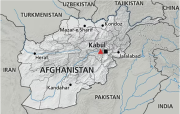Behsudi Hazara Chiefs (Hazaras of Behsud)
Behsudi Hazara Chiefs (Hazaras of Behsud)
Photograph, a posed group portrait of Besudi Hazara chieftains taken by John Burke in 1879-80, possibly at Kabul in Afghanistan. Burke accompanied the British army into Afghanistan in 1878 and worked steadily in the hostile environment of Afghanistan and the North West Frontier Province, recording military and topographical scenes as well as the peoples of the country during the Second Afghan War (1878-80). Burke also photographed many darbars or meetings that took place between British combat leaders and Afghan chiefs which led to the uneasy peace treaties characteristic of the campaign. His two-year Afghan expedition produced a visual document which resulted in his achieving significance as the photographer of the region of the Great Game (the Anglo-Russian territorial rivalry).

Profile
The size of the Hazara population, as with other communities in Afghanistan, is highly uncertain as the country’s authorities have never conducted a national census of the population. However, it is broadly recognized that none of the country’s ethnic groups form a majority, and the exact percentages of each group as part of the national population are estimates and often highly politicized.
The size of the Hazara community has also declined significantly as a result of forced migration, land grabbing and persecution. They were once the largest Afghan ethnic group, constituting nearly two-thirds of the total population of the country before the 19th century. Some estimates suggest that more than half of the Hazaras were massacred, forced to flee or taken into slavery during the 1891-93 Hazara War when the Afghan King Amir Abdur Rahman Khan (1880-1901) led a genocidal campaign of violence against Hazaras. Many of the Hazaras who fled the persecution by Amir Abdur Rahman Khan settled in the Indian subcontinent or Iran, laying the foundation of the Hazara communities that now live in the Pakistani city of Quetta and various districts in Iran’s eastern provinces. These communities have increased in size as more Hazaras who fled from Afghanistan over the past four decades have settled within them, especially in Quetta.

